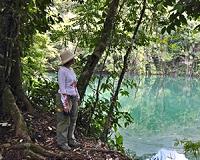| . |  |
. |
England, UK (SPX) Aug 02, 2010 Research at the UK's University of Warwick, and the University of Goettingen in Germany, has found that the use of a particular GM crop in India produced massive benefits in the earnings and employment opportunities for rural Indian women. The research led by Dr Arjunan Subramanian of WMG (Warwick Manufacturing Group) in the University of Warwick found that the use of GM insect-resistant Bacillus thuringiensis toxin (Bt) cotton generated not only higher income for rural workers but also more employment, especially for hired female labour. Since its commercialization in India in the year 2002, the area in which Bt cotton is cultivated increased to 7.6 million hectares in 2008. Several studies show sizable direct benefits of the technology but no study so far has analyzed the gender aspect of this technology. The researchers found that compared with conventional cotton the Bt cotton generated additional employment, raising the total wage income by 40 US dollars per hectare. The largest increase is for hired females with a gain of 55% in average income. This translates to about 424 million additional days of employment for female earners for the total Bt cotton area in India. The researchers found that the Increase in returns to hired female labour is mostly related to higher yields in Bt cotton leading to additional labour being employed to pick the increased production of cotton (harvesting of cotton is primarily a female activity in India). Dr Arjunan Subramanian said: "We also found that the use of Bt cotton also improved female working conditions as the reduction in the amount of family male labour involved in scouting and spraying for pests meant that that labour was reallocated to other household economic activities, previously carried out by female family members, increasing the returns to this labour category. Overall, therefore, Bt cotton enhances the quality of life of women through increasing income and reducing 'femanual' work." The research results come from two household survey. The first was undertaken in a study village where the team collected comprehensive data on household characteristics and interactions across various markets. The study village, Kanzara, is located in the Akola district of Maharashtra, the state with the largest area under cotton in India. Interviews with all village households and institutions were conducted in 2004, capturing all household economic activities and transactions for the 12-month period between April 2003 and March 2004. All farm households cultivate at least some cotton, mostly next to a number of food and fodder crops for subsistence consumption and for sale. The second survey used data from a farm sample survey conducted over a period of 5 years.
Share This Article With Planet Earth
Related Links University of Warwick All About Human Beings and How We Got To Be Here
 Divers Plumb The Mysteries Of Sacred Maya Pools
Divers Plumb The Mysteries Of Sacred Maya PoolsChampaign IL (SPX) Jul 29, 2010 Steering clear of crocodiles and navigating around massive submerged trees, a team of divers began mapping some of the 25 freshwater pools of Cara Blanca, Belize, which were important to the ancient Maya. In three weeks this May, the divers found fossilized animal remains, bits of pottery and - in the largest pool explored - an enormous underwater cave. This project, led by University of I ... read more |
|
| The content herein, unless otherwise known to be public domain, are Copyright 1995-2010 - SpaceDaily. AFP and UPI Wire Stories are copyright Agence France-Presse and United Press International. ESA Portal Reports are copyright European Space Agency. All NASA sourced material is public domain. Additional copyrights may apply in whole or part to other bona fide parties. Advertising does not imply endorsement,agreement or approval of any opinions, statements or information provided by SpaceDaily on any Web page published or hosted by SpaceDaily. Privacy Statement |